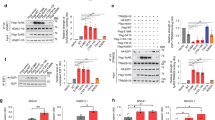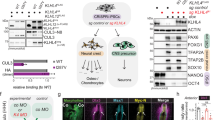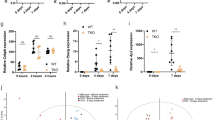Abstract
N-myristoylation is a common form of co-translational protein fatty acylation resulting from the attachment of myristate to a required N-terminal glycine residue1,2. We show that aberrantly acquired N-myristoylation of SHOC2, a leucine-rich repeat–containing protein that positively modulates RAS-MAPK signal flow3,4,5,6, underlies a clinically distinctive condition of the neuro-cardio-facial-cutaneous disorders family. Twenty-five subjects with a relatively consistent phenotype previously termed Noonan-like syndrome with loose anagen hair (MIM607721)7 shared the 4A>G missense change in SHOC2 (producing an S2G amino acid substitution) that introduces an N-myristoylation site, resulting in aberrant targeting of SHOC2 to the plasma membrane and impaired translocation to the nucleus upon growth factor stimulation. Expression of SHOC2S2G in vitro enhanced MAPK activation in a cell type–specific fashion. Induction of SHOC2S2G in Caenorhabditis elegans engendered protruding vulva, a neomorphic phenotype previously associated with aberrant signaling. These results document the first example of an acquired N-terminal lipid modification of a protein causing human disease.
This is a preview of subscription content, access via your institution
Access options
Subscribe to this journal
Receive 12 print issues and online access
$209.00 per year
only $17.42 per issue
Buy this article
- Purchase on Springer Link
- Instant access to full article PDF
Prices may be subject to local taxes which are calculated during checkout




Similar content being viewed by others
Accession codes
References
Resh, M.D. Trafficking and signaling by fatty-acylated and prenylated proteins. Nat. Chem. Biol. 2, 584–590 (2006).
Farazi, T.A., Waksman, G. & Gordon, J.I. The biology and enzymology of protein N-myristoylation. J. Biol. Chem. 276, 39501–39504 (2001).
Selfors, L.M., Schutzman, J.L., Borland, C.Z. & Stern, M.J. soc-2 encodes a leucine-rich repeat protein implicated in fibroblast growth factor receptor signaling. Proc. Natl. Acad. Sci. USA 95, 6903–6908 (1998).
Sieburth, D.S., Sun, Q. & Han, M. SUR-8, a conserved Ras-binding protein with leucine-rich repeats, positively regulates Ras-mediated signaling in C. elegans. Cell 94, 119–130 (1998).
Li, W., Han, M. & Guan, K.L. The leucine-rich repeat protein SUR-8 enhances MAP kinase activation and forms a complex with Ras and Raf. Genes Dev. 14, 895–900 (2000).
Rodriguez-Viciana, P., Oses-Prieto, J., Burlingame, A., Fried, M. & McCormick, F. A phosphatase holoenzyme comprised of Shoc2/Sur8 and the catalytic subunit of PP1 functions as an M-Ras effector to modulate Raf activity. Mol. Cell 22, 217–230 (2006).
Mazzanti, L. et al. Noonan-like syndrome with loose anagen hair: a new syndrome? Am. J. Med. Genet. A. 118A, 279–286 (2003).
Schubbert, S., Shannon, K. & Bollag, G. Hyperactive Ras in developmental disorders and cancer. Nat. Rev. Cancer 7, 295–308 (2007).
Tartaglia, M. & Gelb, B.D. Molecular genetics of NS. in Monographs in Human Genetics, Vol. 17. NS and Related Disorders: A Matter of Deregulated RAS Signaling (ed. Zenker, M.) 20–39 (Karger Press, Basel, Switzerland, 2009).
Berger, S.I., Posner, J.M. & Ma'ayan, A. Genes2Networks: connecting lists of gene symbols using mammalian protein interactions databases. BMC Bioinformatics 8, 372 (2007).
Boutin, J.A. Myristoylation. Cell. Signal. 9, 15–35 (1997).
Tartaglia, M. et al. Somatic mutations in PTPN11 in juvenile myelomonocytic leukemia, myelodysplastic syndromes and acute myeloid leukemia. Nat. Genet. 34, 148–150 (2003).
Araki, T. et al. Mouse model of NS reveals cell type- and gene dosage-dependent effects of Ptpn11 mutation. Nat. Med. 10, 849–857 (2004).
Loh, M.L. et al. Mutations in PTPN11 implicate the SHP-2 phosphatase in leukemogenesis. Blood 103, 2325–2331 (2004).
Sternberg, P.W. Vulval development. in Wormbook (ed. The C. elegans Research Community) doi/10.1895/wormbook.1.6.1 http://www.wormbook.org (2005).
Eisenmann, D.M. & Kim, S.K. Protruding vulva mutants identify novel loci and Wnt signaling factors that function during Caenorhabditis elegans vulva development. Genetics 156, 1097–1116 (2000).
Kishore, R.S. & Sundaram, M.V. ced-10 Rac and mig-2 function redundantly and act with unc-73 trio to control the orientation of vulval cell divisions and migrations in Caenorhabditis elegans. Dev. Biol. 241, 339–348 (2002).
Tosti, A. et al. Loose anagen hair in a child with Noonan's syndrome. Dermatologica 182, 247–249 (1991).
Xenarios, I. et al. The Database of Interacting Proteins: 2001 update. Nucleic Acids Res. 29, 239–241 (2001).
Kerrien, S. et al. IntAct-open source resource for molecular interaction data. Nucleic Acids Res. 35, D561–D565 (2007).
Chatr-aryamontri, A. et al. MINT: the Molecular INTeraction database. Nucleic Acids Res. 35, D572–D574 (2007).
Ma'ayan, A. et al. Formation of regulatory patterns during signal propagation in a Mammalian cellular network. Science 309, 1078–1083 (2005).
Bader, G.D., Betel, D. & Hogue, C.W.V. BIND: the Biomolecular Interaction Network Database. Nucleic Acids Res. 31, 248–250 (2003).
Beuming, T., Skrabanek, L., Niv, M.Y., Mukherjee, P. & Weinstein, H. PDZBase: a protein-protein interaction database for PDZ-domains. Bioinformatics 21, 827–828 (2005).
Dijkstra, E.W. A note on two problems in connexion with graphs. Numerische Mathematik 1, 269–271 (1959).
Tartaglia, M. et al. Gain-of-function SOS1 mutations cause a distinctive form of NS. Nat. Genet. 39, 75–79 (2007).
Allanson, J.E. Noonan syndrome. J. Med. Genet. 24, 9–13 (1987).
van der Burgt, I. et al. Clinical and molecular studies in a large Dutch family with Noonan syndrome. Am. J. Med. Genet. 53, 187–191 (1994).
Voron, D.A., Hatfield, H.H. & Kalkhoff, R.K. Multiple lentigines syndrome. Case report and review of the literature. Am. J. Med. 60, 447–456 (1976).
Sarkozy, A. et al. LEOPARD syndrome: clinical aspects and molecular pathogenesis. in Monographs in Human Genetics, Vol 17. NS and Related Disorders: A Matter of Deregulated RAS Signaling (ed. Zenker, M.) 55–65 (Karger Press, Basel, Switzerland, 2009).
Roberts, A. et al. The cardiofaciocutaneous syndrome. J. Med. Genet. 43, 833–842 (2006).
Utsumi, T. et al. Amino acid residue penultimate to the amino-terminal Gly residue strongly affects two cotranslational protein modifications, N-myristoylation and N-acetylation. J. Biol. Chem. 276, 10505–10513 (2001).
Vachon, L., Costa, T. & Hertz, A. GTPase and adenylate cyclase desensitize at different rates in NG108–15 cells. Mol. Pharmacol. 31, 159–168 (1987).
Sulston, J.E. & Hodgkin, J. Methods. in The Nematode Caenorhabditis elegans (ed. Wood, W.B. and The Community of C. elegans Researchers) 587–606 (Cold Spring Harbor Laboratory Press, Cold Spring Harbor, New York, USA, 1988).
Mello, C.C., Kramer, J.M., Stinchcomb, D. & Ambros, V. Efficient gene transfer in C. elegans after microinjection of DNA into germline cytoplasm: extrachromosomal maintenance and intergration of transforming sequences. EMBO J. 10, 3959–3970 (1991).
Duerr, J.S. Immunohistochemistry. in WormBook (ed. The C. elegans Research Community) doi/10.1895/wormbook.1.105.1 (2006).
Acknowledgements
We are indebted to the affected individuals and families who participated in the study, the physicians who referred the subjects, A. Fire (Stanford University School of Medicine, Stanford, California) and J.D. McGhee (University of Calgary, Calgary, Canada) for plasmids, and C. Ramoni, S. Venanzi and T. Squatriti (Istituto Superiore di Sanità, Rome, Italy) and the Open Laboratory (IGB-CNR, Naples, Italy) for experimental support. Some nematode strains used in this work were provided by the Caenorhabditis Genetics Center (University of Minnesota, Minneapolis, Minnesota), funded by the US National Institutes of Health (NIH) National Center for Research Resources. We also thank M.C. Silengo (Università di Torino, Turin, Italy), S. Spranger (Praxis fuer Humangenetik, Bremen, Germany), I.M. Gaspar (Egas Moniz Hospital, Lisbon, Portugal) and D.R. Bertola (HC/FMUSP, Saão Paulo, Brazil) for their contribution in DNA sampling and valuable clinical assistance. This research was funded by grants from Telethon-Italy (GGP07115) and 'Convenzione Italia-USA-malattie rare' to M.T., the NIH (HL71207, HD01294 and HL074728) to B.D.G., SBCNY (P50GM071558) to A.M. and R.I. the German Research Foundation (DFG) (ZE 524/4-1) to M.Z. and IRCCS-CSS (Ricerca Corrente 2009) to F.L.
Author information
Authors and Affiliations
Contributions
V.C. and V.F. were responsible for mutation analysis and biochemistry, E.D.S., S.M. and P.B. were responsible for the generation and phenotypic characterization of transgenic C. elegans strains, L.A.P., J.M., W.S. and A.L. performed high-throughput resequencing, A.S., F.L. and C.R. did mutation analysis, A.M. and R.I. did protein network analysis, S.C. did the confocal laser scanning microscopy, A.C., E.F. and D.M. were responsible for functional studies, G.Z., L.M., M.C.D., D.B., K.K., C.A., A.S., G.B.F., R.T., M.Z. and B.D. obtained DNA specimens from patients and did clinical evaluation, and B.D.G. and M.T. were responsible for the project planning, data analysis and preparation of manuscript.
Corresponding authors
Supplementary information
Supplementary Text and Figures
Supplementary Tables 1–5 and Supplementary Figures 1–3 (PDF 1498 kb)
Rights and permissions
About this article
Cite this article
Cordeddu, V., Di Schiavi, E., Pennacchio, L. et al. Mutation of SHOC2 promotes aberrant protein N-myristoylation and causes Noonan-like syndrome with loose anagen hair. Nat Genet 41, 1022–1026 (2009). https://doi.org/10.1038/ng.425
Received:
Accepted:
Published:
Issue Date:
DOI: https://doi.org/10.1038/ng.425
This article is cited by
-
New insights on Noonan syndrome’s clinical phenotype: a single center retrospective study
BMC Pediatrics (2022)
-
Structure of the SHOC2–MRAS–PP1C complex provides insights into RAF activation and Noonan syndrome
Nature Structural & Molecular Biology (2022)
-
Structural keys unlock RAS–MAPK cellular signalling pathway
Nature (2022)
-
Molecular and clinical profile of patients referred as Noonan or Noonan-like syndrome in Greece: a cohort of 86 patients
European Journal of Pediatrics (2022)
-
Structure–function analysis of the SHOC2–MRAS–PP1C holophosphatase complex
Nature (2022)



